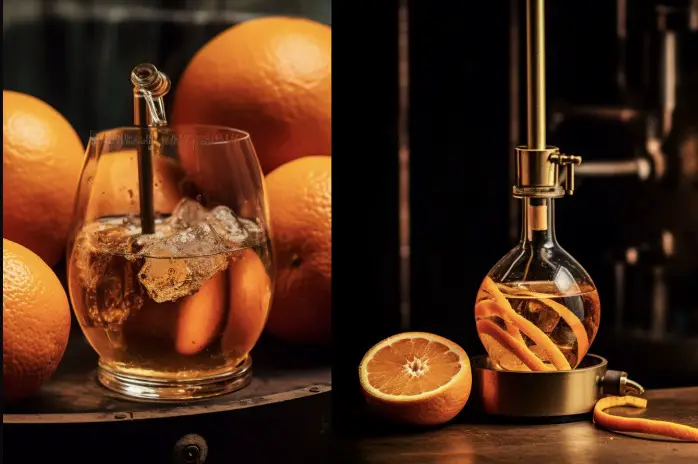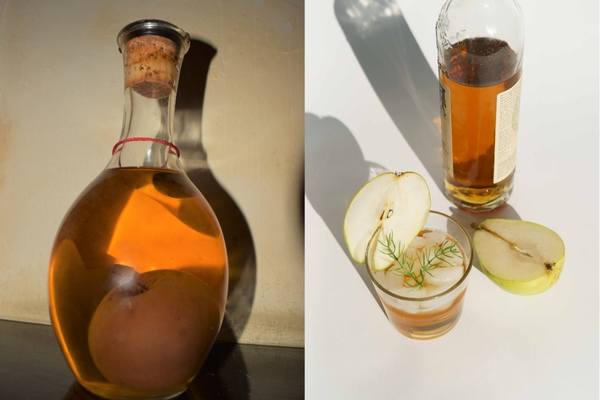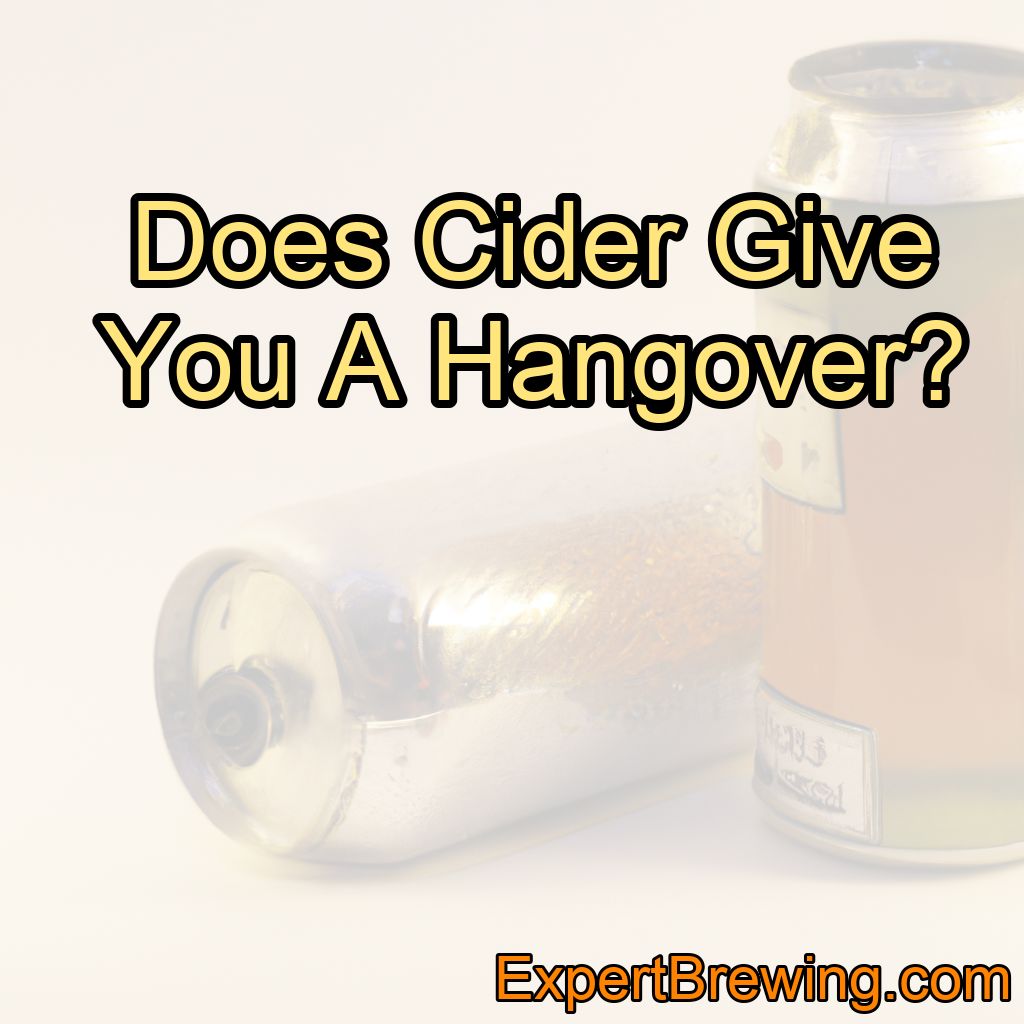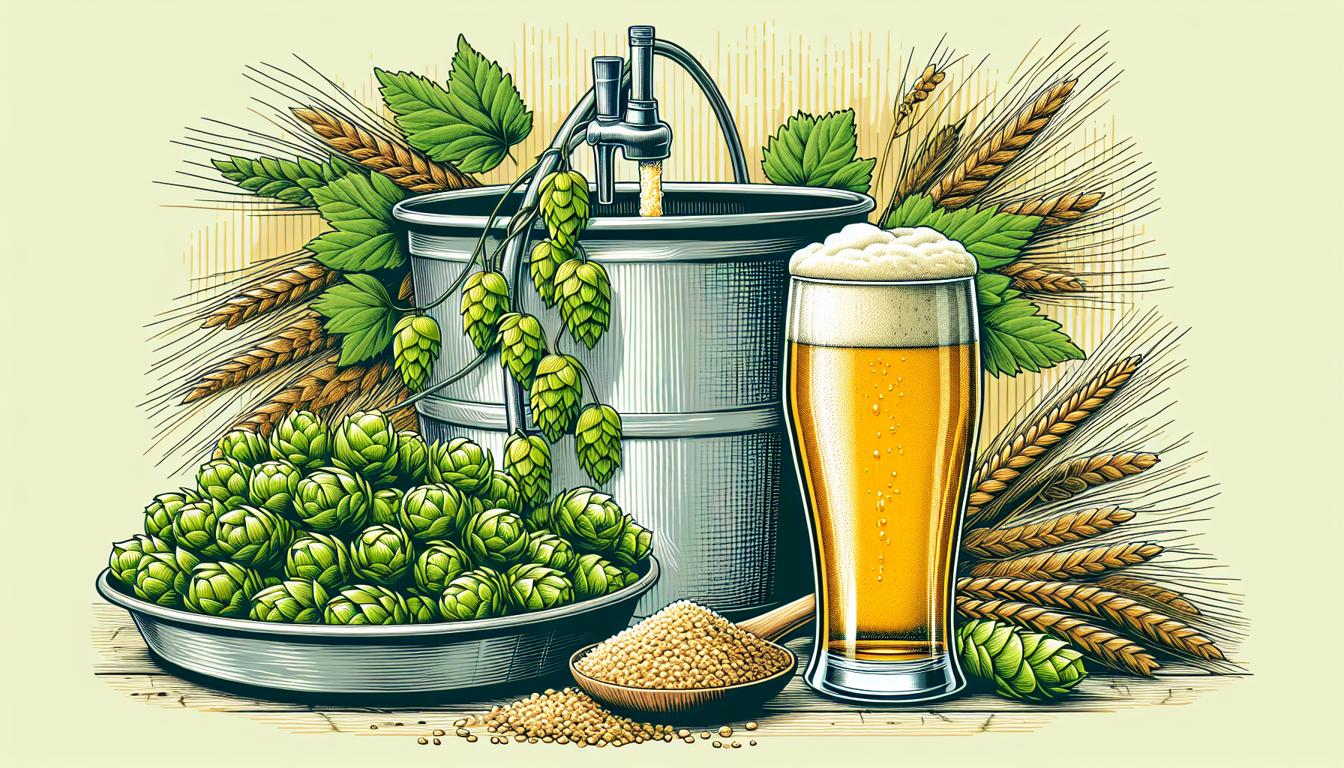Alcohol is made by fermentation and can be further concentrated by distillation.
They are two different processes that can be carried out sequentially, and there is no distillation without a previous fermentation!
Some beverages, such as wine, cider, mead and beer are made exclusively through fermentation whereas spirits such as brandy, whiskey, vodka and tequila are made via the added step of distillation.
The quality and taste of the distilled product depends largely on the purity of the fermented alcohol and thus the quality of the fermentation.
Some products, usually those that are suitable for consumption directly after fermentation but also after distillation, can be served as “fortified” meaning that the original fermented product is made “stronger” by adding its own distillate to it.
Differences Between Fermented and Distilled Alcoholic Beverages Explained
Distillation and fermentation are two common processes for producing alcoholic beverages.
Heat distillation involves heating a liquid to vaporize its components, while fermentation occurs when yeast converts sugar into alcohol.
Although the end results of both processes involve alcoholic beverages, fermentation itself can only reach so far in terms of alcohol production (around 20% max!) and to get any further, you will need to distill (concentrate) your ferment.
When you have reached the limits of fermentation, there is only one way to go if you want higher alcohol percentages – distillation.
Distillation can be done either very warm or very cold (freeze distillation or “jacking”), but the same principle of separating the water from the alcohol is at play.
Distillation typically yields higher-proof liquors than fermented products as it concentrates the alcohol content of a liquid through boiling, condensation and collection.

To produce distilled drinks such as whiskey, vodka or rum, grain mash is heated until its volatile compounds become vaporized.
After being administered with other filtration techniques to adjust taste and clarity, the resulting liquid has significantly higher alcohol by volume (ABV) compared to beer or cider that result from fermentation.
Fermentation on the other hand begins with converting sugar molecules into ethanol using yeast enzymes; this process produces lower ABV liquids such as beer, wine or cider in comparison to their distilled counterparts.
Depending on specific factors such water temperature and pH levels that contribute towards flavor composition and fragrant profiles of a given beverage categorized under different beer types – lager beers tend toward a light banana/clove profile for instance – a multitude variations can be produced depending on design goals of concentration versus flavor complexity .
What Is Distillation?
Distillation is the process of separating a liquid mixture into several individual components by virtually eliminating the undesired components.

This process is employed in industries ranging from fuel and pharmaceuticals to spirits, due to its ability to separate mixtures based on their boiling point; distilling is often used for purification as well as re-concentration when it comes to producing alcoholic drinks.
It is a relatively simple technique that can, with the right equipment, be performed by anyone at home.
Distilling differs from fermentation in that, unlike fermentation, distillation does not involve any creation of alcohol — instead, the ethanol already present in a fermented beverage is just further concentrated through evaporation and condensation.
The result can be anything from vodka or whiskey to rum or tequila depending on the product’s ingredients and desired flavor profile.
It is, however, important to understand that the two processes are not separate. There is no distillation without a previous fermentation and all the distillation does is to concentrate the alcohol of a ferment.
In summary, distillation involves concentrating a version of an already alcoholic beverage product; this allows higher alcohol content while retaining flavor complexity.
What Is Fermentation?
Fermentation is the process of converting sugar, starch, and other simple carbohydrates into alcohols and carbon dioxide.

This process provides the alcohol, flavor and aroma associated with most typical beverages like beer, hard cider or wine.
In contrast to fermentation, distillation is a form of separation widely used for purifying liquids using heat (or cooling). By heating a fermented beverage past its boiling point for ethanol (78 degrees Celsius), it can be separated from other non-alcoholic components present in the source solution.
Fermentation requires much more moderate temperatures and can be done by anyone at home with minimal equipment.
Distilled beverages tend to have a much higher concentrations of alcohol than those produced solely through fermentation; they are also typically clearer since they have been filtered of larger particles during this process.
It is the key biochemical process used to make alcoholic beverages such as beer, wine, mead, and commercial distillation spirits.
Fermentation occurs when yeast or sometimes bacteria act on simple sugars present in a solution without oxygen to produce ethanol/alcohol.
Pros and Cons of Distillation and Fermentation for Producing Alcohol Beverages and spirits.
At the heart of any spirit is the process of distillation and fermentation. Both processes are closely linked, yet they result in two distinct methods of alcohol production. Distillation involves heating and cooling a liquid to create a concentrated version, while fermentation creates alcohol through the conversion of sugar into ethanol with yeast.
Each process has its own unique set of benefits and downsides to consider. The biggest advantage that distilling provides is a higher level proof beverage – alcohol distilled from grain or grapes typically has an ABV starting around 40%. This can be further elevated when additional distillations occur.
On the other hand, this method usually relies on additional steps to create flavoring such as aging in wooden caskets and adding flavorings, whereas fermentation will produce something with more complex flavors already present within in it due to exposure from yeast during formation.
However generally fermenting produces beverages that are weaker in strength compared to distilled versions (ABV usually topping off around 20-25%). Ultimately each method comes down personal preference based on intended use for any given beverage produced from either approach.
Producing Alcoholic Beverages by Distillation:
Pros:
- Increased alcohol content: Distillation allows for the removal of impurities and water, resulting in a higher alcohol concentration in the final product.
- Enhanced flavor and aroma: The distillation process can concentrate and refine the flavors and aromas of the base ingredients, creating a more nuanced and complex beverage.
- Versatility: Distillation enables the production of a wide range of alcoholic beverages, including spirits like vodka, rum, whiskey, and brandy, which have distinct characteristics and flavors.
- Preservation: Distilled beverages generally have a longer shelf life compared to fermented beverages due to their higher alcohol content, which acts as a preservative.
- Control over quality: Distillation provides greater control over the production process, allowing for the removal of unwanted compounds and ensuring consistent quality.
Cons:
- Complexity and equipment requirements: Distillation involves more complex and sophisticated equipment compared to fermentation alone, increasing the initial investment and operational costs.
- Loss of some volatile compounds: While distillation can enhance flavors, it may also result in the loss of some delicate and volatile compounds present in the base ingredients, potentially altering the taste profile.
- Higher alcohol content risks: Distilled beverages have a higher alcohol content, which can increase the risk of burns and explosions when heat distilling.
- Limited variety of base ingredients: Some base ingredients may not be suitable for distillation, limiting the range of flavors and styles that can be produced through this method.
- Regulation and legal considerations: The production and distribution of distilled beverages are subject to stricter regulations and licensing requirements in many countries, adding additional administrative burdens for producers.
Producing Alcoholic Beverages by Fermentation Alone:
Pros:
- Simplicity: Fermentation is a relatively straightforward process that requires less equipment and technical expertise compared to distillation, making it more accessible for small-scale producers.
- Retention of natural flavors: Fermentation preserves the natural flavors and characteristics of the base ingredients, resulting in a more authentic and unadulterated taste.
- Wide range of base ingredients: Fermentation allows for the use of a wide variety of fruits, grains, and other natural products, enabling the production of diverse styles and flavors of beverages.
- Cultural and historical significance: Many traditional and artisanal beverages are produced solely through fermentation, reflecting regional flavors and cultural heritage.
- Lower alcohol content options: Fermented beverages, such as beer and wine, typically have lower alcohol content than distilled spirits, making them more suitable for casual consumption and social settings.
Cons:
- Limited alcohol content: Fermentation alone cannot produce beverages with higher alcohol concentrations, which may restrict the variety of products that can be made.
- Potential for variability: Fermentation is a biological process influenced by various factors like temperature, yeast strains, and fermentation time, leading to variations in flavor and quality.
- Shorter shelf life: Fermented beverages generally have a shorter shelf life compared to distilled spirits due to their lower alcohol content, making them more susceptible to spoilage.
- Risk of off-flavors: Without distillation, fermented beverages may be prone to developing off-flavors or undesirable characteristics, affecting the overall drinking experience.
- Longer production time: Fermentation usually requires a longer time to complete compared to distillation, which can impact production efficiency and time-to-market for producers.
In summary, producing alcoholic beverages by distillation offers the advantage of higher alcohol content, enhanced flavors, versatility in product range, longer shelf life, and greater quality control.
However, it comes with the drawbacks of increased complexity, equipment requirements, potential loss of volatile compounds, higher alcohol content risks, and regulatory considerations.

On the other hand, producing beverages by fermentation alone is simpler, retains natural flavors, allows for a wide range of base ingredients, carries cultural significance, and offers lower alcohol content options.
However, it has limitations in alcohol concentration, potential variability, shorter shelf life, risk of off-flavors, and longer production time.
Choosing between distillation and fermentation depends on the desired outcomes, resources, and target market for the beverage production.
Examples of Popular Alcoholic Drinks Created with Either Process or a Combination of Both
Distilling and fermenting alcohol are two distinct processes that can produce entirely different outcomes. But there is no distlling without some sort of fermentation that is, all distilled spirits come from a fermented base.
In distilling, alcohol is concentrated using heat to boil off liquids and capture their vapors. This vapor is then condensed and distilled again to purify the ethanol content.
Some popular alcoholic drinks made using this method include gin, vodka, whiskey, brandy and tequila.
| Alcoholic Beverage | Distilled? |
|---|---|
| Vodka | Yes |
| Gin | Yes |
| Rum | Yes |
| Tequila | Yes |
| Whiskey | Yes |
| Brandy | Yes |
| Cognac | Yes |
| Scotch | Yes |
| Bourbon | Yes |
| Absinthe | Yes |
| Sake | No |
| Beer | No |
| Wine | No |
| Champagne | No |
| Cider | No |
| Mead | No |
| Sherry | Fortified |
| Port | Fortified |
| Vermouth | Fortified |
| Cachaça | Yes |
| Pisco | Yes |
| Baijiu | Yes |
| Soju | Yes |
| Rakia | Yes |
| Grappa | Yes |
| Moonshine | Yes |
On the other hand, fermentation is a process used to make beer and wine by converting sugars into alcohol without boiling or adding heat.
During this process an enzyme breaks down the sugar molecules into simpler compounds allowing for yeast to break them down further into ethanol and carbon dioxide gases. Popular alcoholic drinks created with a combination of both processes include champagne, hard cider, mead and sake.
Fortified wines are in-between!
Fortified wines represent a fascinating category in the world of fermented and distilled beverages. These unique libations owe their distinct character to the process of fortification, which involves the addition of distilled spirits, typically brandy, during or after fermentation.

This technique not only enhances the alcoholic strength of the wine but also imbues it with complexity and longevity.
Historically, fortified wines gained prominence due to their ability to withstand long journeys at sea, remaining stable and drinkable during voyages. This durability made them popular choices among sailors and explorers, leading to their widespread distribution and subsequent appreciation around the world.
One of the most iconic examples of fortified wine is Port, a rich and robust wine that hails from the Douro Valley in Portugal. Traditionally crafted from indigenous grape varieties such as Touriga Nacional, Touriga Franca, and Tinta Roriz, Port undergoes a unique fermentation process. During fermentation, when the grape must reaches a specific sugar level, brandy is added to halt fermentation, preserving the natural sweetness and boosting the alcohol content.
This fortification technique results in a fortified wine with rich flavors of ripe dark fruits, chocolate, and sometimes a hint of spice. Ports are often aged in oak barrels, allowing them to develop a velvety texture and a complex bouquet over time. They come in various styles, including Vintage Port, Tawny Port, and Ruby Port, each offering a different experience to the discerning palate.
Sherry is another notable fortified wine that holds a special place in the world of fermentation and distillation. Originating from the region of Jerez in southern Spain, Sherry is crafted from Palomino, Pedro Ximénez, and Moscatel grapes.

The production of Sherry involves a unique process known as the Solera system, which consists of blending young wines with older ones in a tiered system of barrels.
This continuous fractional blending gives Sherry its characteristic range of styles and flavors, ranging from bone-dry and crisp Fino to nutty and rich Oloroso.
The fortification of Sherry occurs early in the fermentation process, halting the transformation of sugar into alcohol and resulting in a wine that can range from bone-dry to intensely sweet.
Madeira, named after the Portuguese island from which it originates, is yet another noteworthy fortified wine. It boasts a long and illustrious history dating back to the 15th century when the wine was discovered to improve with age when exposed to the heat and movement of long sea voyages.
Madeira undergoes a unique process called estufagem, where the wine is heated to high temperatures and then allowed to cool slowly over an extended period.
This deliberate oxidative aging process imparts distinct flavors of caramel, dried fruits, and nuts to the wine, resulting in a complex and vibrant profile.
Fortified wines continue to captivate wine enthusiasts and connoisseurs alike with their remarkable depth of flavor, aging potential, and versatility. Whether enjoyed on their own or as an accompaniment to various dishes, these wines offer a captivating journey through the world of fermentation, distillation, and the artistry of winemaking.
What about freeze distillation?
Freeze distillation is a method of creating alcoholic beverages by using cold temperatures to concentrate the alcohol content in a fermented beverage. This process involves freezing the liquid and then removing the ice, which contains less alcohol and more water, leaving behind a more concentrated alcohol content.

The process of freeze distillation is relatively simple. The fermented beverage is placed in a container and then placed in a freezer. As the temperature drops, ice crystals begin to form. The ice is then removed from the container, leaving behind a more concentrated liquid that contains a higher percentage of alcohol.
One of the main advantages of freeze distillation is that it is a relatively simple and low-cost process compared to traditional distillation. However, there are also several disadvantages to this process. One of the main disadvantages is that it can be difficult to control the concentration of alcohol, which can lead to variations in the final product. Additionally, freeze distillation may not remove all of the impurities that traditional distillation can remove, which can result in a lower quality product.
There are several types of spirits that can be made using freeze distillation. One of the most popular is applejack, which is made from fermented apple cider that has been freeze-distilled. Ice cider is another popular product that is made using this process. In addition to these products, there are also a variety of other spirits that can be made using freeze distillation, including eau de vie, grappa, and other types of fortified wines.
In conclusion, freeze distillation is a simple and low-cost method of creating alcoholic beverages with a higher alcohol content. While there are some advantages to this process, there are also several disadvantages to consider, including the potential for variations in the final product and the inability to remove all impurities.
Nonetheless, it remains a popular method for producing certain types of spirits, including applejack and ice cider.
Conclusion
In conclusion, distillation and fermentation are two unique processes used to create alcoholic beverages. Both have advantages and disadvantages depending on what type of drink is being produced.
The main difference between them is the boiling point: whereas distilling requires the raw material to reach its boiling point in order for it to separate into fractions, fermentation only requires sugars from ingredients such as fruit or grains be allowed to convert into alcohol over time with no heat required.
Whether you prefer a light beer crafted through fermentation or an aged whiskey distilled over many years, understanding both methods can help deepen your appreciation for all types of drinks! Join us today if you want more information about this fascinating topic!




